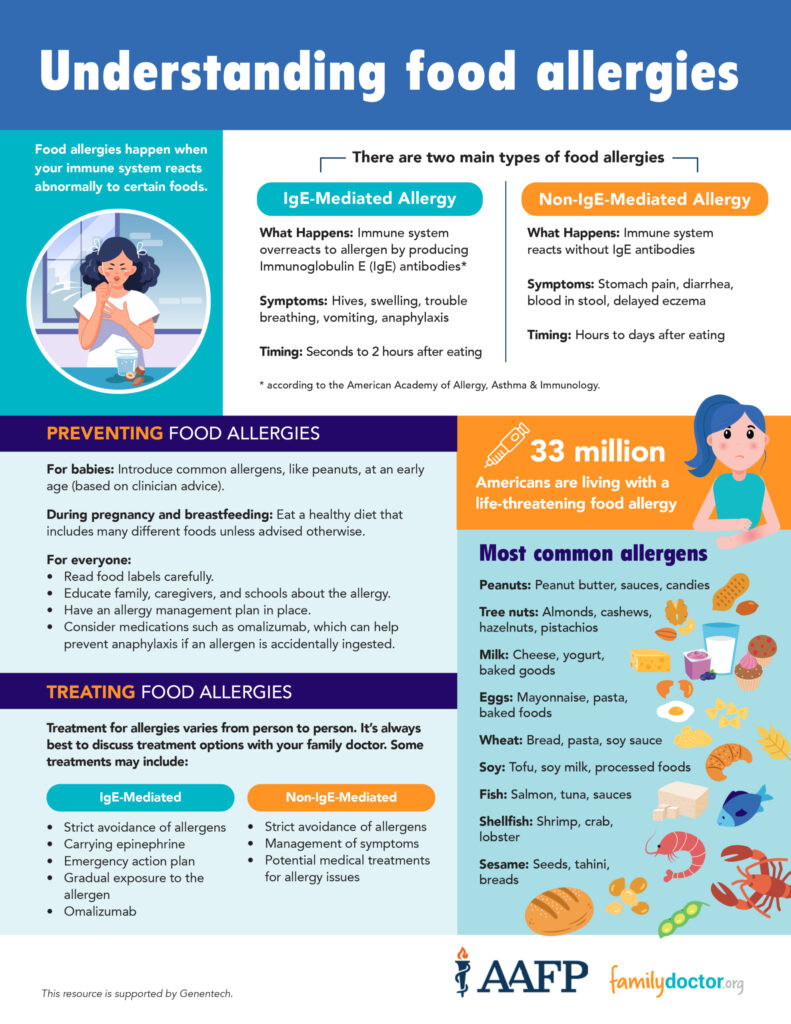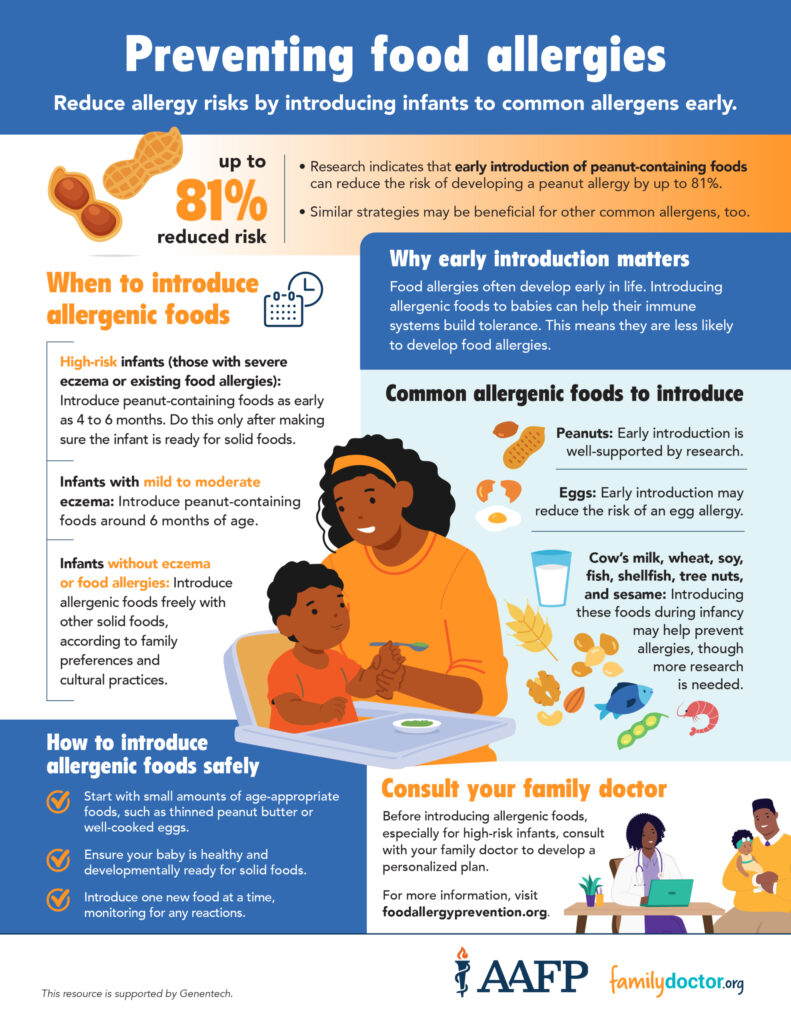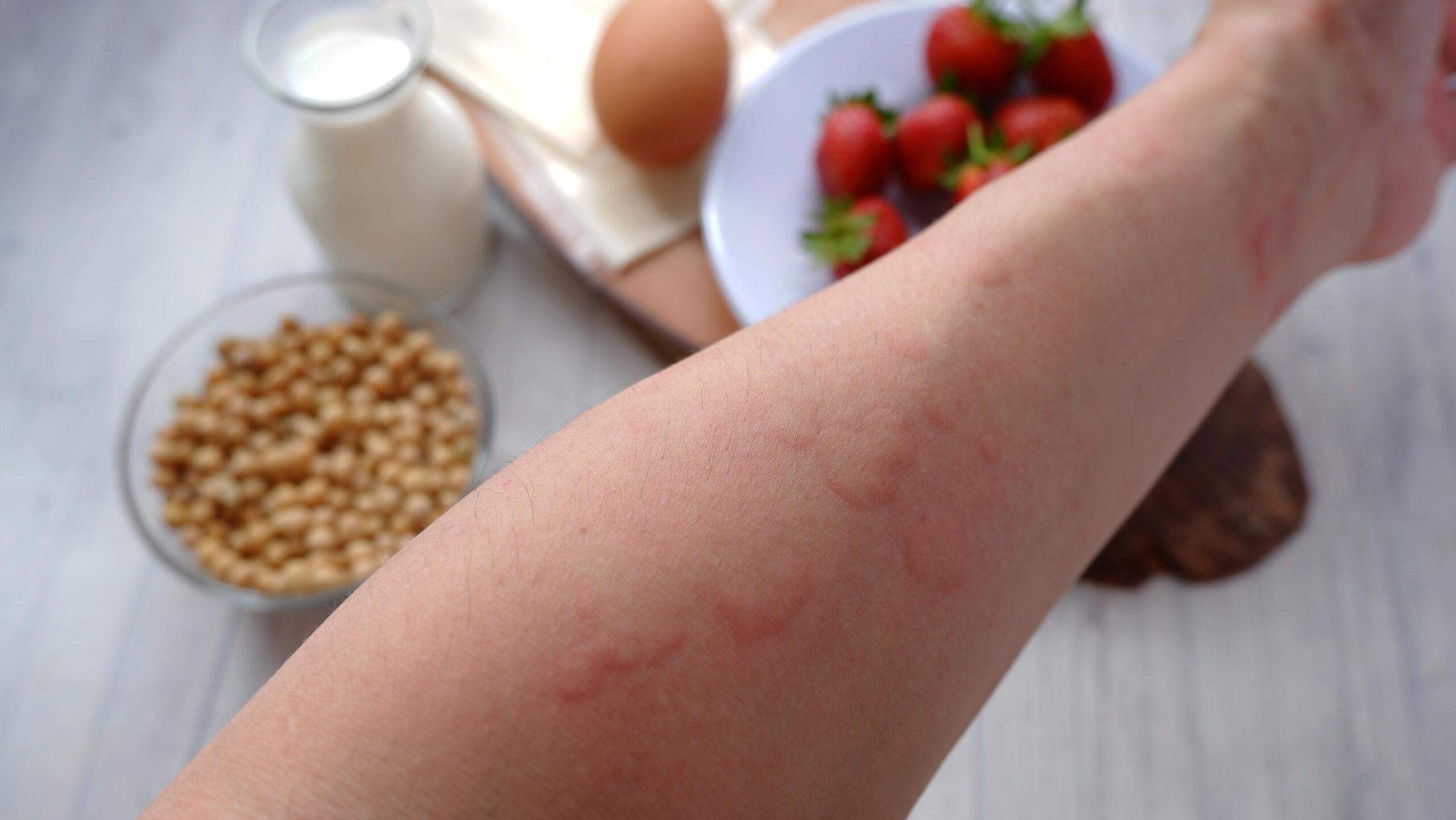What are food allergies?
A food allergy is your immune system’s abnormal reaction to certain foods. The immune system is the part of your body that fights infection. A food allergy can be mild or serious, and even a tiny bite of the food containing the allergen can be dangerous for someone with a food allergy. It’s important to note that this type of allergy differs from a food intolerance. Food intolerance, such as lactose (dairy) intolerance, is an unpleasant symptom triggered by food (bloating, gas, stomach cramps). It doesn’t involve your immune system.
Understanding food allergies: Key facts and causes
- There are 33 million Americans living with a life-threatening food allergy. Of that total, 1 in 13 children have life-threatening food allergies
- There are 9 major food allergens that cause most allergic reactions, including milk, eggs, peanuts, tree nuts, soy, wheat, fish, sesame, and shellfish. These 9 foods account for 90% of food allergies.

Symptoms of a food allergy
Symptoms of a food allergy are usually immediate — within seconds to 2 hours. The most common symptoms of food allergy include:
- Hives (large bumps on the skin)
- Swelling
- Pale or itchy skin
- Itchiness or tingling in the mouth
- Metallic taste in the mouth
- Coughing, trouble breathing, or wheezing
- Throat tightness
- Cramps in your abdomen
- Diarrhea
- Vomiting
In severe cases, a reaction can lead to anaphylaxis, a deadly combination of breathing difficulties, including asthma, skin reactions such as eczema and cardiovascular issues (low blood pressure, dizziness, loss of consciousness). Anaphylaxis blocks your airway and requires immediate 911 medical attention.
What causes food allergies?
Although people can be allergic to any kind of food, most food allergies are caused by tree nuts, peanuts, milk, eggs, soy, wheat, fish, sesame, and shellfish. Most people who have food allergies are allergic to fewer than 4 foods.
Additionally, some food additives, such as yellow food dye and aspartame (artificial sweetener), can cause an allergic reaction. Although sugar and certain fats are not considered healthy choices, they are not associated with food allergies.
How to identify and avoid allergens
Through appropriate testing, your doctor will identify your food allergy as one of two types:
- Immunoglobulin E (IgE)‐mediated: This is when your immune system produces IgE antibodies, which can lead to hives, swelling, trouble breathing, vomiting, and anaphylaxis within seconds to two hours after consuming the trigger food.
- Non-IgE-mediated: This is when your immune system reacts without IgE antibodies. With this type, you can experience stomach pain, diarrhea, blood in stool, and delayed eczema within hours to days after eating the trigger food.
How are food allergies diagnosed and tested?
If you’ve had an allergic reaction to a food, see your doctor. They will examine your symptoms and ask about your health history.
Be prepared to give your doctor as much history as possible about your allergic reaction Some things to note include:
- The symptoms you have after eating the food
- How long after eating the food these symptoms occurred
- How much of the food you had
- How often the reaction has occurred
- Whether it occurs with other foods
- Whether it occurs every time you eat the food
- What type of medical treatment, if any, you received after having symptoms
Your doctor may put you on an elimination diet. This is when you don’t eat any suspicious foods for a while then gradually add them back one at a time. Your doctor also may perform a blood test to measure the levels of IgE antibodies specific to different foods. Elevated levels of IgE for a specific food suggest a possible allergy but are not always definitive.
Another test is a skin prick test. It works like this:
- A medical professional will apply a small amount of liquid containing a suspected food allergen on your skin.
- They will lightly prick your skin under the drop to allow the allergen to penetrate.
- If a raised, red, itchy bump (wheal) develops within 15-30 minutes, it indicates you may have a possible food allergy.
Finally, your doctor may perform an oral food challenge (OFC) test. It is considered the gold standard in testing for food allergies. It involves a person eating increasing
amounts of the suspected allergen (under medical supervision) until they reach the amount that might trigger a reaction. If no reaction occurs, the person can usually continue to eat that food.
Once a food allergy is diagnosed, avoid the food that causes it. If you have an allergy, you must read the labels on all prepared foods you eat. Your doctor can help you learn how to avoid eating the wrong foods.
Pediatric diagnosis and testing
Testing children for food allergies differs slightly. Recent studies have found that some food allergies — such as peanut allergies — can be prevented if they are introduced and treated within the baby’s first year. The National Institute of Allergy and Infectious Diseases recommends that infants with severe eczema, egg allergy, or both be introduced to foods containing peanuts as early as four months of age to reduce the risk of a peanut allergy. Talk to your doctor before introducing foods containing peanuts at this early age.
Similar strategies may be beneficial for other common allergens, too. Always talk to your doctor first. They typically follow this testing plan:
- High-risk infants (those with severe eczema or existing food allergies): Introduce peanut-containing foods as early as four to six months. Do this only after making sure the infant is ready for solid foods.
- Infants with mild to moderate eczema: Introduce peanut-containing foods around six months of age.
- Infants without eczema or food allergies: Introduce allergenic foods freely with other solid foods, according to family preferences and cultural practices.
Common allergenic foods to introduce
- Peanuts: Early introduction is well-supported by research.
- Eggs: Early introduction may reduce the risk of an egg allergy.
- Cow’s milk, wheat, soy, fish, shellfish, tree nuts, and sesame: Introducing these foods during infancy may help prevent allergies, though your doctor’s guidance and more research is needed.
How to introduce allergenic foods safely to children
- Start with small amounts of age-appropriate foods, such as thinned peanut butter or well-cooked eggs.
- Ensure your baby is healthy and developmentally ready for solid foods.
- Introduce one new food at a time, monitoring for any reactions.
If your child has food allergies, give their school and other care providers instructions of what foods to avoid. Tell them what to do if the food is accidentally eaten. Many children usually outgrow allergies to milk, eggs, soybean products, and wheat. People rarely outgrow allergies to peanuts, tree nuts, fish, and shellfish
Preventing food allergies: Steps to stay safe
Most important is to avoid the food that caused the allergic reaction. Next, eliminate the possibility of cross contamination in food preparation areas. An example of this is to properly wash and sanitize your hands, cutting boards, and utensils that were used to prepare the food that causes the allergic reaction.
Plan for direct exposure and cross contamination by talking with your hosts who are preparing food in their home, tell restaurant servers, and read instructions on prepared food packaging.

Emergency preparedness: Handling reactions
While there is no cure for a food allergy, there are new therapies that increase tolerance to food items so that if you accidentally eat something you are allergic to, your body might not have an extreme reaction.
If you have a mild reaction (itching, sneezing, hives, or rash), your doctor will give you antihistamines and oral or topical steroid medicine. A severe reaction of anaphylaxis is treated with a medicine called epinephrine. This medicine must be given quickly to save your life. If you or your child has a severe allergy, your doctor may give you a prescription for an epinephrine pen to always carry. Your doctor or pharmacists can show you how and when to use the pen. A person having a serious allergic reaction should be taken by ambulance to a hospital emergency room.
Also, plan by preparing:
- Creating an individual or family emergency plan: This contains information about what food the individual is allergic to and how to respond with medicine or calling 911.
- Assemble an emergency supply kit: This kit should contain all that the individual needs, including medicine and a written reminder to call 911. It is helpful to prepare two kits — one for home and one for the car.
Practical tips for daily food allergy management
Living with food allergies can cause fear and anxiety when you’re eating at a restaurant or someone else’s home. You will always wonder if your problem food is combined with the rest of the meal. Also, if you have food allergies to most of the eight common foods, you can feel frustrated by the restrictions in your life. There’s no cure yet. People manage allergies by avoiding the food and carrying emergency medicine like epinephrine. This checklist can help:
- Identify the foods that cause the person’s allergic reaction.
- Know alternative food names (casein for milk or albumin for egg).
- Understand cross-contamination.
- Read labels. Pay close attention to the “contains” statements.
- Don’t be afraid to talk to your server or the restaurant manager when dining out. If in doubt, leave the restaurant.
- Keep your emergency kit with you always. If you normally keep it in the car, bring it inside the restaurant.




